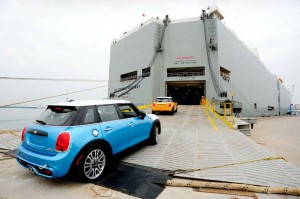
Mini celebrated the 3 millionth car built at the Oxford, England plant. The 2015 models are now in production.
It was two, three four for Mini last week: the maker marking the roll-out of the 3 millionth car produced at its Oxford assembly plant, including the 2 millionth Mini earmarked for export.
As for four, the British maker also offered up the first drive in its next-generation four-door Hardtop. A five-door, actually, with the hatchback scheduled to reach U.S. showrooms in December.
Mini launched production of its original microcar at the end of 1958 at plants in Longbridge and Oxford, vehicles sold as both the Austin Seven and Morris Mini-Minor. In 1962 the Austin Seven was renamed Austin Mini and Mini became a brand of its own in 1969.
But the latter years of the 20th Century were marked by turmoil – and the near collapse of the British auto industry. Mini was bounced around, along with other brands like Rover and Jaguar, nationalized then privatized, before eventually winding up in the hands of BMW. An all-new generation of the Mini was launched in 2001.
The first of the new hatchbacks reaching U.S. shores a decade ago. The American market is now Mini’s largest.
Today, four out of five Minis are exported to 100 countries, making it the third-largest automobile exporter in the UK. Overseas demand has helped the maker expand the Oxford plant from a single-shift operation – using 2,400 workers to produce 300 cars a day – to a three-shift mill churning out 1,000 vehicles daily and employing 4,000.
Plant Oxford is the center of a three factory production triangle with additional sites in Swindon and Hams Hall. Since 2000, the BMW Group initially invested around 1.75 billion British pounds in these operations – about US$2.85 billion. BMW has pumped in another 750 million pounds over the past three years to expand Mini’s export operations.
The Oxford plant today produces five Mini models: the Hatchback, Clubman, Cabrio, Coupe and Roadster. The Countryman and Paceman roll out of the Magna Steyr plan in Graz, Austria. To keep up with demand, Mini added production of the Hatch model at the VDL Nedcar plant in the Netherlands in July. The Dutch factory is expected to take on another Mini model next year.
Production In July of this year, the VDL Nedcar plant in Born, in The Netherlands started production of the Mini Hatch. It is expected that a second model will be built in the Dutch plant as from 2015.
To mark this month’s 3 millionth model milestone, the Oxford plant rolled out a 5-door painted in the red-white-blue color combination of the British Union Jack. The 2-millionth Mini for export was a Mini Hatchback in Volcanic Orange ordered by a customer from Japan.
While we didn’t get the chance to drive those two particular cars, we did get behind the wheel of the new Mini Cooper S Hardtop – which is likely to become a critical new offering for the U.S. market. It’s expected to fill a gap between the smaller two-door and the much larger Countryman.
The increased wheelbase and length, at 101.1 and 158 inches, respectively, offer more space for rear seat passengers as well as easier access, which is particularly important for young parents who need to buckle their kids into safety seats. An extra advantage is the increased luggage compartment, which now holds 13.1 cubic feet, nearly 2.4 cf more than the 2-door. That jumps to 40.7 cf with the rear seats folded down. There’s also a new split-fold rear seat.
The first drive with the Cooper S proved that the new Mini variant handles very well, the car is agile, though it does lose a bit of that distinctive go-kart feeling that purists love, and which Mini has maintained with the latest generation of its 2-door. That’s probably no surprise considering the new 4-door is 6.3 inches longer overall, and gains 2.9 inches of wheelbase, as well as another 135 pounds over the two-door.
(Marchionne plans to increase Ferrari production. For more, Click Here.)
With 192-horsepower, the Mini’s 2.0-liter turbocharged 4-cylinder engine offers a reasonable amount of power for most buyers. To its credit, Mini isn’t giving up on the manual gearbox, like so many other manufacturers. The Cooper S will come standard with a six-speed stick. For those who prefer an automatic, the six-speed is a $1,250 option.
(Click Here for details about the most and least expensive areas for car insurance.)
Mileage with the automatic is reasonable, if not especially outstanding, at 25 City, 38 Highway.
As with the two-door Mini we drove earlier this year, return buyers will discover a number of changes in the latest-generation Cooper family. Among other things, the speedometer has been moved to the gauge cluster, so it is now immediately visible through the steering wheel.
(To see Honda’s new virtual towing system, Click Here.)
Atop the center stack you will now find the Hardtop’s infotainment system – which is offered with an optional navi unit. A quirky light ring envelops the display, changing colors to express such things as the vehicle’s operating mode and whether you’ve got the climate control set to cool or warm.
Look for the new 2015 Mini Cooper S Hardtop to reach U.S. showrooms by year-end, with a base price of $24,395, plus $850 in delivery charges.
(Paul A. Eisenstein contributed to this review.)


